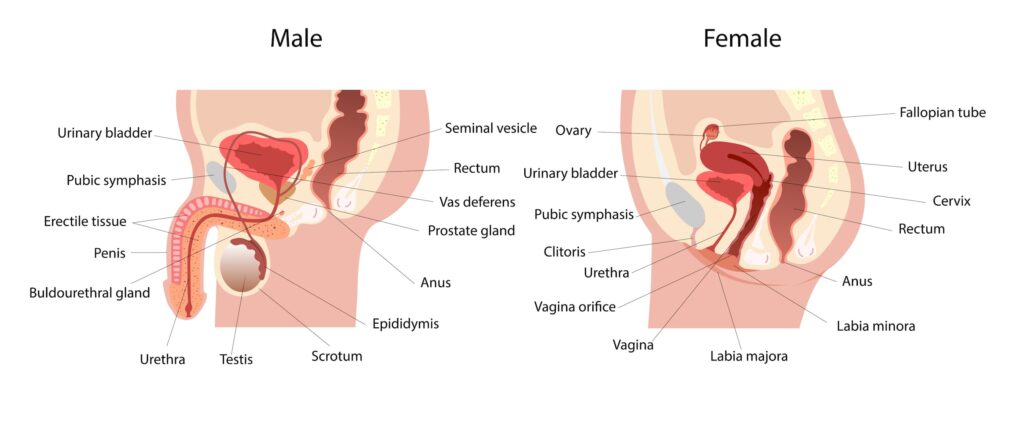The urethra is the tube that allows urine to flow out from your bladder to be expelled. Due to certain conditions, the urethra may be constricted, blocking the flow of urine. If left untreated, this may cause inflammation and infection along the urinary tract, including the bladder, prostate, and kidneys.

Urethral reconstructive surgery is often needed to treat urethral strictures (narrowing due to scar formation) due to trauma, inflammation, or frequent urinary tract infections. Structurally, as men have a much longer urethra than women, it is more common for men to experience urethral damage and require surgical treatment.
Urethral stricture is a condition where the urethra narrows as a result of scar tissue build-up. It is possible to have more than one stricture. Treatment is also depending on the location and length of the strictures.
Urethral strictures can cause various voiding issues and can be uncomfortable and affect your daily activities. If left untreated, a urethral stricture can cause further health complications such as bladder and kidney damage, frequent infections and low ejaculation volume and subfertility in men.

This refers to a procedure where the urethral stricture is slowly stretched so that the circumference of the stricture is larger.
The procedure involves the doctor inserting a tiny wire through the urethra into the bladder. Dilators (thin rods) of progressively larger sizes are then passed over the wire to gradually expand the size of the urethral stricture.
A urethral dilation is typically performed under local, regional or general anaesthesia and takes only a few minutes. However, it is important to note that the procedure may need to be repeated from time to time as strictures may recur. You may need to perform self-calibration of the urethra for a period of time to reduce the risk of stricture recurrence. If the stricture recurs, repeat dilation is not usually effective in providing long-term relief; hence, surgery is recommended.
Also used to treat urethral stricture; the procedure involves incising the stricture under direct visualisation endoscopically using a specialised tool called a urethrotome. Think of it as a rigid thin telescope. It is then inserted into the urethra to examine the narrowing before an incision is made. To further assess your condition, the scope may also be inserted all the way into the bladder.
The procedure is done under regional or general anaesthesia and usually takes between 15 – 30 minutes.
As a general guide, the method is typically used for the first episode of urethral stricture. It is most effective in strictures that are relatively short in length and are not overly dense. It may also be used for recurrent and slightly more complex urethral strictures. Success rates may differ on a case-by-case basis.
Meatotomy is a procedure to surgically open the hole of the penis with no stitching. Meatoplasty, on the other hand, involves surgically opening the hole of the penis and stitching the edges together.
These 2 procedures are done when the hole/opening of the penis, called the urethral meatus, is too small, a condition known as meatal stenosis. The condition affects around 10% of males.
This condition makes it difficult for the patient to urinate. Some symptoms include feeling pain while urinating, needing to urinate often, and spraying/abnormal urine stream. If left untreated, urethral meatus could cause urinary tract infection and, in severe cases, kidney impairment.
Depending on the severity, the procedure could involve the use of a topical anaesthetic or general anaesthetic. Once the anaesthetic takes effect, the meatus will be cut or reconstructed to make the opening bigger.
During the recovery process, it is normal to experience slight pain or burning sensations when urinating. This should subside fairly quickly.
The procedure is done when there is a significant amount of scar tissue within the urethra. This could be due to an injury or prior procedures, including urethral trauma, prior surgery, or STDs.
If your doctor suspects that there are strictures in your urethra, you will be sent for a retrograde urethrogram (a type of X-ray) or cystoscopy to confirm the location and length of the stricture.
The incision depends on the site of the stricture. Most commonly, it is done on the perineum (the area between the scrotum and anus), but it can also be done on the underside of the penis or in the scrotum.
In simpler cases, the procedure involves cutting a part of the urethra with the scar tissue and connecting the two ends. In more complicated cases where a longer length of urethra is affected, tissue grafts may be required, which can be taken from the mouth.
The incision will then be closed, and a drain will be placed and kept for a few days. A catheter will also be placed to allow the urine to leave your body while the area heals. Typically, absorbable sutures are used. These are stitches that will be absorbed by your body so you won’t have to go back to your doctor to have them removed.
Hopefully this article helped better explain what urethral stricture disease is, the various treatments available, and what one can expect should one need treatment. Urethral strictures, if left untreated, can lead to serious complications because prolonged and severe blockages can damage the kidneys. Thankfully, they can be treated.

MBBS, MRCSed, MMED(Surgery)
Dr Terence Lim is a Senior Consultant Urologist with a subspecialty in Uro-Oncology. He is also the Medical Director at Assure Urology & Robotic Centre. His clinical interests include Uro-Oncology, Minimally-invasive Urological Surgery, Urinary Stone Disease, Endourology and Prostate Health.
Prior to his private practice, Dr Terence Lim spent almost two decades in public healthcare. He served as the Senior Consultant and Chief of the Department of Urology at Changi General Hospital (CGH). In addition, he is currently a Visiting Consultant at CGH. Dr Lim was also the director of CGH’s Advanced Surgical Centre, a committee dealing with complex surgeries, including robotic surgeries.
Your health is important to us and some conditions require immediate attention. For emergencies, please contact us at 9835 0668.

MBBS, MRCSed, MMED(Surgery)
Dr Terence Lim is a Senior Consultant Urologist with a subspecialty in Uro-Oncology. He is also the Medical Director at Assure Urology & Robotic Centre. His clinical interests include Uro-Oncology, Minimally-invasive Urological Surgery, Urinary Stone Disease, Endourology and Prostate Health.
Prior to his private practice, Dr Terence Lim spent almost two decades in public healthcare. He served as the Senior Consultant and Chief of the Department of Urology at Changi General Hospital (CGH). In addition, he is currently a Visiting Consultant at CGH. Dr Lim was also the director of CGH’s Advanced Surgical Centre, a committee dealing with complex surgeries, including robotic surgeries.
Your health is important to us and some conditions require immediate attention. For emergencies, please contact us at 9835 0668.
No issue is too small. Contact any of our friendly staff and we will get back to you as soon as possible.
Reach out to us for expert urological care.
For enquiries, leave a message and our friendly team will get in touch with you.
For urgent enquiries after office hours, call or WhatsApp us at (65) 9835 0668.
Monday – Friday: 9:00AM – 5:00PM
Saturday: 9:00AM – 12:30PM
Sunday & Public Holiday: CLOSED

© 2023 All Rights Reserved | Assure Urology & Robotic Centre | Terms & Conditions